INTRODUCTION
Many of our customers use DOE in their scientific research fields – for both academic research purposes and advanced industrial application development.
In this application section, you will find a review of DOE usage in several selected applications, based on inquiries from Holo/Or’s customers over time.
For more information, please contact us.
STED Microscopy
In recent years, Stimulated Emission Depletion (STED) microscopy has become a popular method due to its unique microscopic properties and advanced performance, such as higher imaging speed and super-resolution imaging capacity, and has wide applications in many fields.
STED microscopy is based on depleting fluorescence in specific regions of the sample, while leaving a center focal spot active to emit fluorescence. This is done by using two overlapping beams which act as excitation and depletion laser consecutively.
In this configuration, the STED laser must possess zero-fields in the center and maximum in the periphery which exhibits a doughnut-shaped phase pattern. The most common means is to use diffractive optical elements (DOE) to get a doughnut shape – hence a vortex phase plate is the obvious solution.
Other possibilities for 3D imaging are round p phase plates.
Relevant products: Vortex Lens, p Phase-Plate
Figure 1. Spiral Phase Plate used in STED microscopy1
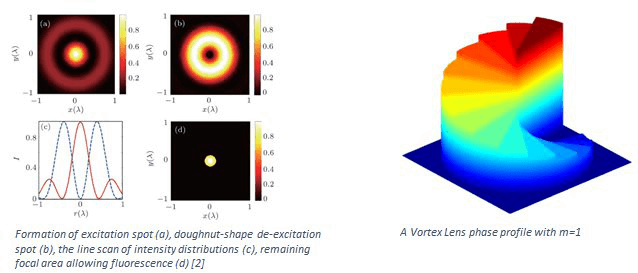
Two-Photon Fluorescence Microscopy
Similar to the standard confocal microscopy, two-photon microscopy uses a laser to excite a fluorescent tag within a sample and measures the emitted light. However, unlike the lasers used for confocal microscopy (which provide single-photon excitation), the lasers used in two-photon microscopy excite by using near simultaneous absorption of two long wavelength (~800 nm) photons. Longer wavelengths are scattered to a lesser degree than shorter ones, which is a benefit to high-resolution imaging.
In addition, these lower-energy photons are less likely to cause damage outside the focal volume and penetrate more deeply into tissues.
Typical applications include living cells and tissue imaging.
By using Holo/Or’s 1D multi-spot elements, one can project several spots with desired separation distance and excite multiple particles at the same time.
Relevant products:1D Multi-Spot, HEDS
Figure 2. Beam Splitter used in Fluorescence microscopy4
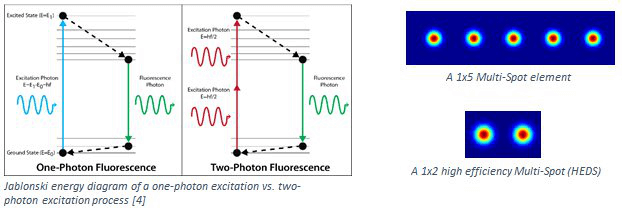
Bessel-Like Beam Generation
Bessel-Like beams are unique beams which have some immunity to diffraction – as it propagates, it does not diffract and spread out (as oppose to usual light waves). The description of such a beam is by using a Bessel function, which leads to a predicted cross-sectional profile of a set of concentric rings.
When focused, Bessel beams have a far longer depth of focus compared to a Gaussian beam, with a corresponding decrease of energy density at focus.
Typical applications include imaging and increased depth of focus for non-linear frequency conversion. One method of generating a Bessel-like beam is by using a Diffractive Axicon.
Relevant products: Diffractive Axicon, Elongated Focus

Optical Mode Generation & Conversion
For many applications, it is useful to convert the fundamental laser mode TEM00 to a higher order of Hermite-Gaussian beams modes (whose amplitude profiles are separable in x and y using Cartesian coordinates) or Laguerre-Gaussian beam modes (which are circularly symmetric).
Typical uses include flow cytometry, optical communications, biological cell microscopy and scanning applications.
Holo/Or has developed a new product line for Hermite-Gaussian mode conversion and p-phase plates that generates higher Hermite-Gaussian modes (any mode is possible).
For Laguerre-Gaussian modes the relevant products are Spiral Phase Plates (i.e. Vortex Lens).
Relevant products: Mode-conversion DOEs, Vortex Lens
Figure 4. Mode Convertor
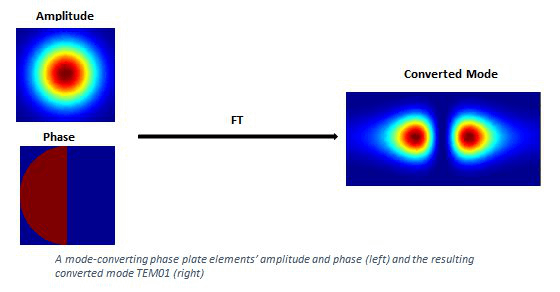
Optical Tweezing / Atomic Traps
Optical Tweezers are the use of light to manipulate microscopic objects as small as a single molecule or atom. A laser beam, usually a high-power IR light, is focused by a high-quality microscope objective to a spot in the specimen plane. This spot creates an “optical trap” which is able to hold the small particle at its center.
Typical applications include biological and nanotechnological fields – tracking of movement (e.g. of bacteria) and measurement of small forces.
Relevant products: Diffractive Axicon, Vortex Lens
Figure 5. Optical Tweezing with Axicon and Vortex Spiral phase10,11
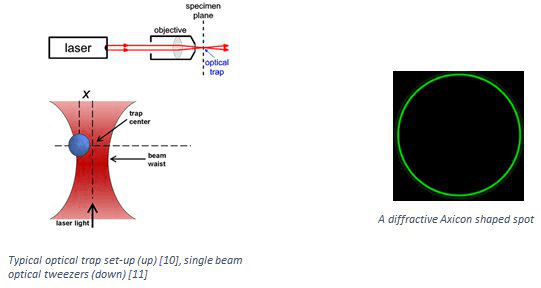
Airy Beams Generation
An Airy beam is a non-diffracting waveform which doesn’t spread out as the beam propagates and gives the appearance of curving as it travels.
The Airy beam also has the characteristic of freely accelerating. As it propagates, it bends so as to form a parabolic arc.
A cross section of an ideal Airy beam would reveal an area of principal intensity, with a series of adjacent, less luminous areas trailing off to infinity. Typical applications include manipulation of small particles such as microfluidic engineering and cell biology.
Relevant products: Airy beam generator
Figure 6. Airy Beam13
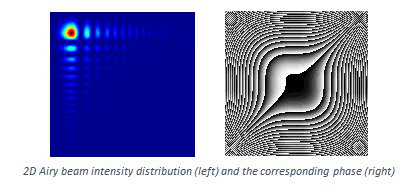
Coherent Beam Combining
In coherent beam combining applications, the goal is to combine several low-power laser beams into a single high-power beam with not only correspondingly higher power, but also with preserved beam quality. This technique allows to increase the power of the laser far beyond what it is possible to obtain from a single conventional laser.
Let us consider a triple-spot element (1×3 spots) for example: an incoming Gaussian beam will lead to three beamlets exiting the DOE with pre-designed separation angles and intensities. While reversing the orientation of the DOE, making the beams enter the un-diffracted side, a single output can be obtained if the incoming beams are mutually coherent and adjusted such that they enter the element at the same angles and have the same amplitudes.
This combination can be repeated as required for several incoming beams.
Typical applications are military/defense: anti-missile and other directed-energy laser weapons.
Relevant products: Multi-Spot
Figure 7. Beam Combining

Flow Cytometry Analysis
Flow cytometry is a technology that is used to analyze the physical and chemical characteristics of particles in a fluid as it passes through a laser light. When labeled cells are passed by a light source, the fluorescent molecules are excited to a higher energy state. Upon returning to their resting states, the fluorochromes emit light energy at longer wavelengths, allowing measurement of cell size and internal complexity of the structure.
Flow cytometry is a widely used to technique to study many aspects of cell biology and is routinely used in the diagnosis of disease (especially blood cancers) and in basic and clinical research.
Relevant products: 1D Multi-Spot (for parallel channel cytometry), Top-Hat
Figure 8. Flow Cytometry with Top-Hat
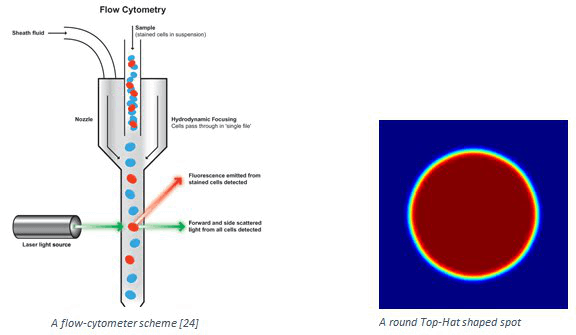
references
STED Microscopy
[1] http://cpb.iphy.ac.cn/article/2016/1815/cpb_25_3_030701.html
[2] http://mrd.snu.ac.kr/research/STED.php
Two-Photon Fluorescence Microscopy
[3]https://cogsci.stackexchange.com/questions/13829/voltage-sensitive-dyes-technique-2-photons-microscopy-vs-confocal-microscopy
[4] http://web.mit.edu/solab/Documents/Assets/So-2PF%20light%20microscopy.pdf
Bessel-Like Beam Generation
[5] https://www.phys.ksu.edu/reu2014/joshuanelson/BesselBeam1.pdf
[6] https://www.osapublishing.org/oe/fulltext.cfm?uri=oe-24-15-17433&id=348017
[7] https://www.osa-opn.org/home/articles/volume_24/june_2013/featurres/unraveling_bessel_beams/
Optical Tweezing / Atomic Traps
[8] https://blocklab.stanford.edu/optical_tweezers.html
[9] http://large.stanford.edu/courses/2007/ph210/sung2/
[10] http://spie.org/newsroom/touchless-tweezing?SSO=1
Airy Beams Generation
[11] https://www.eng.tau.ac.il/research/FEL/7.pdf
Optical Mode Generation & Conversion
[12] https://www.rp-photonics.com/hermite_gaussian_modes.html
[13] http://cds.cern.ch/record/796806/files/0410021.pdf
Coherent Beam Combining
[14]http://www.laserfocusworld.com/articles/print/volume-48/issue-06/features/beam-combining-cranks-up-the-power.html
[15] https://www.rp-photonics.com/coherent_beam_combining.html
[16] http://onlinelibrary.wiley.com/book/10.1002/9783527652778
Flow Cytometry Analysis
[17] https://www.news-medical.net/life-sciences/What-is-Flow-Cytometry.aspx
[18] http://clinchem.aaccjnls.org/content/46/8/1221




